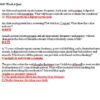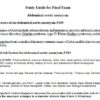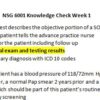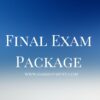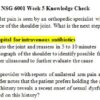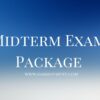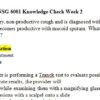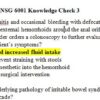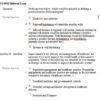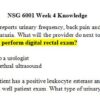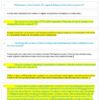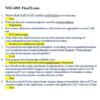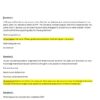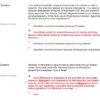Description
NSG 6001 Final Exam 2 – Question and Answers
- Maintenance of an Isometric ST-segment during exercise is the response of?
- What is one of the common causes of a Saccular Abdominal Aneurysm?
- Your patient of 58 years of age has chronic hypertension. You follow the guidelines for management as described by the American Heart Association and now have your patient fully medicated and dosed with three separate antihypertensive medications without control of the blood pressure. What should be your next step in the management of this patient?
- The diagnostic accuracy of stress testing is decreased among women compared to men for what reasons?
- Any patient presenting with symptomatic bradycardia should be referred to a cardiologist for management. Is this statement true or false?
- Chronic, non-communicable diseases account for disproportionate costs to the healthcare system. According to the World Health Organization, what percent of preventable deaths and disabilities occur in the Americas related to chronic non-communicable diseases?
- On the echocardiography during the ETT you notice the following change: abnormal left ventricular ejection fraction. What do these changes suggest related to this patient?
- What are the two types of bradycardia recognized by the American Heart Association?
- Aortic aneurysms are described based on their shape. Aneurysms may be fusiform or saccular. When an aneurysm forms as a weakness or bleb on one side of the aorta, it is described as what form of aneurysm?
- There is a wide range of antibiotic agents that can be selected to treat a urinary tract infection. Unfortunately, there is often failure of treatment noticed. From the list below, which would be considered a common reason for treatment failure in UTI?
- You see a 60-year old African American male in your clinic with a recent diagnosis of hypertension. He asks you what he should restrict in his diet, and is particularly interested in limiting his sodium intake. What amount of sodium intake would you recommend on a daily basis for this patient?
- A 35 year old female arrives at your clinic. She has had diabetes and peripheral artery disease for the past 5 years. You decide to obtain an ETT. The insurance company argues that this is inappropriate. You justify the ETT because you are planning secondary strategies to prevent future heart disease. Where could one find the supporting data for these guidelines?
- A 65-year old white male arrives in your clinic with general complaints of slight abdominal discomfort.
- He has a known history of smoking two packs per day for 40 years and hypertension. He also has COPD and has been treated numerous times with oral steroids. You consider several optional diagnoses. Of the ones listed below, which should be included as a potential top suspect in your choice of diagnosis?
- Of the answers below, which would be include in defining a positive Exercise Echocardiogram?
- You receive a report back on the suspected abdominal aortic aneurysm for your patient. It confirms your suspicion of AAA. The report describes the aneurysm as a symmetric weakness of the entire circumference of the aorta. You know that this form of aneurysm is referred to as what kind of aneurysm?
- Ischemic changes on ECG during ETT is highly predictive of CAD. What is another important strong predictor of CAD that you might see during an ETT?
- You tell a patient that he has a murmur. He says he has been told this before, but wonders what causes the unique sounds of a murmur. Which of the following would be your best option?
- Your practice partner just ordered an exercise echocardiography 2DE for a patient with suspected cardiovascular risk. This patient has known resting wall motion abnormalities. Why would this not be the best test to assess this patient’s cardiac risk?
- Overall, the risk for abdominal aortic aneurysm is greater among:
- What are two of the most common forms of Exercise Stress Tests used today?
- You have confirmed that your patient does indeed have an abdominal aortic aneurysm. In teaching your patient about symptoms to report immediately to the vascular surgeon, you instruct the patient to report which of the following?
- Your patient is morbidly obese and cannot sit on a bicycle or walk a treadmill. She also has marked and severe emphysema. You need to make an assessment of the risk of significant CAD and your patient’s family says that their relative had their diagnosis based on an ultrasound echocardiography. What facts would influence your decision regarding the family request for echo assessment?
- Automaticity is a property common to all cardiac cells. Is this statement true or false?
- You are considering adding an adjunctive form of testing to detect wall motion abnormalities during the ETT. You-select Echocardiography as the added testing. You choose this test because you know that echocardiography does what when added to a standard ETT?
- More than half of all cardiac arrhythmias involve the atria. (NSG 6001 Final Exam)
- Medicaid is mandated to be provide by each state through federal codes. Each state must offer Medicaid exactly as the federal government prescribes. True or false?
- What three conditions definitely alter the results of echocardiography in determining CAD?
- Your patient cannot sit on a bicycle and has difficulties walking a treadmill with limit capacity for exercising. Still, you know that the ETT is the preferred test for CAD. You consider adding a pharmacological agent to get to maximum heart rate. What agent would be the most commonly use agent to assist in an ETT?
- By standard criteria, how is a positive stress test define?
- For an uncomplicated UTI you choose to order TMP-SMZ for your patient. What is the recommended duration of therapy that you should considered?
- Your patient has a maximum age-predicted heart rate of 180. During the exercise, he reaches a heart rate of 140 and then states he can no longer exercise. You see no evidence of ischemia on the ECG. This would be diagnostic for what condition?
- Your patient asks you what causes a rupture of an abdominal aortic aneurysm. You know the answer is most often:
- What criterion does the American Heart Association use to classify relative bradycardia?
- Changes in Medicare are a method the government uses to make changes to reimbursement schedules for healthcare. Currently, Medicare reimburses nurse practitioners for all services, even those deemed to be exclusive to nursing?
- What is the leading cause of death for women in the United States? (NSG 6001 Final Exam)
- When there is a consequential loss of structural integrity of the abdominal aorta, the resulting issue is what condition?
- Abdominal aortic aneurysms are often asymptomatic. What percent of AAA’s are discover in asymptomatic patients?
- Narrowed coronary arteries or plague rupture within the arteries of the coronary system may directly cause which condition?
- When a murmur is first heard, it is important to determine if it is due to a pathological condition or benign. For an experienced practitioner, it is always easy to determine the cause of a murmur merely by listening to the sound. Is this statement true or false?
- What purpose does the principle of fidelity serve in the provider/patient relationship?
- You see a 75-year old female in your clinic today complaining of urinary incontinence. She is otherwise healthy based upon her last visit. She states that her mother told her this would happen someday because it happens to every woman at some age. What would you tell this patient?
- Population disease management is a term use to describe:
- What is consider the first-line initial approach to test for CAD?
- Your 56-year old patient presents with bradycardia with a rate of 55 and first degree AV block. The patient is hemodynamically stable and is not experiencing any syncope or chest pain. History includes previous myocardial infarction. Home medications include beta blockers, daily aspirin. Lab work is non-significant for electrolyte imbalance. You decided to treat this patient for the arrhythmia to prevent future destabilization. From the choices below, which might be the appropriate first measure to consider? (NSG 6001 Final Exam)
- We all know that collaboration is integral to becoming a successful nurse practitioner. Among collaborations, however, only one can be consider as the most important. While each example below is important, which is the most important collaboration? The one that occurs:
- Medicare hospital insurance (Part A) is fund through what system?
- BPH is not a risk factor for Prostate cancer. Is this statement true or false?
- The leads on the ECG showing ischemic changes during or immediately after an ETT can correlate roughly to the culprit artery or arteries with significant CAD. Is this true or false?
- What do you know regarding ischemia that is confine to only the posterior and or lateral segments of the left ventricle?
- Your patient underwent an exercise stress test for CAD. There is significant elevation of the ST-segment. What do you need to know about these changes to manage your patient’s care? (NSG 6001 Final Exam)
- A 55-year old man is refer to your clinic. He has been sedentary all of his life, is gaining weight and wishes to get into better physical shape. He has never had any chest pain or shortness of breath when walking or climbing a flight of stairs. Before recommending a vigorous exercise routine for this patient, you order what test?
- As patients that entrust our care to another individual, we always expect honesty to avoid leading us down a deceptive pathway in our healthcare decisions. Adherence to which principle compels providers to be truthful?
- Of the following, which is the best answer when asked for an advantage of echocardiogram exercise testing over thallium stress testing?
- Spread of genital herpes only occurs during the time period with active lesions. Is this statement true or false?
- Tachyarrhythmias cause a drop in commonly blood pressure, cardiac output, syncope, shortness of breath, and chest pain. What phenomenon most often occurs during these arrhythmias to cause these symptoms?
- Your patient has a maximum age-predicted heart rate of 180. During the exercise he reaches a heart rate of 140 and then states he can no longer exercise. You see evidence of ischemic changes on the ECG. This would be predictive of what condition?
- Your mentor says that you should be prepare to know how to determine the maximum heart rate for your patient during the ETT. How is the age-predicted maximum heart rate during an ETT determined?
- Specifically, when is an ETT consider to be negative?
- Your patient presents complaining of incontinence of urine. He states that this happens every time soon after he urinates. What type of incontinence is your patient experiencing? (NSG 6001 Final Exam)
- In CAD, after both systolic and diastolic dysfunction have occurred, the typical pattern of chest pain and related EKG changes occur. During an EKG, you should expect to see ST-segment and T-wave changes that are central to demonstration of ischemia occurring relatively late in the ischemic cascade. Is this true or false?
- Check out our latest courses on NURS 6551.

